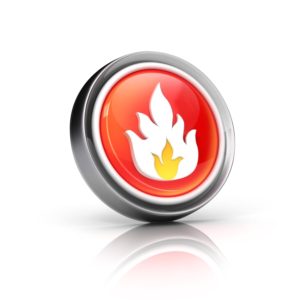
Not all fires are the same, and people who study fires place them in different classes. These are A, BC, D, F and K. A Class D fire occurs when metal is set on fire. Metals that can ignite are unusual, and Class D fires are rare. The metals that are most problematic include sodium, aluminum, potassium, lithium and magnesium.
Pure sodium, for example, ignites when it comes into contact with water, and lithium batteries are notorious for igniting for seemingly no reason. Class D fires usually start with small metal shavings, since large chunks of metal disperse heat too efficiently to ignite. Click here for the Best-Selling Fire Safety Products.
Because they burn metal, Class D fires are unusual in the home and most often happen in labs and industrial plants such as refineries. Still, it’s a good idea to know about these fires and know how to put them out. Class D fires are dangerous and can spread quickly if they’re not controlled.
Water should never be used on a Class D fire, for water intensifies the flames. Instead, the best way to extinguish class D fire is with dry powder. The powder is often made of sodium chloride, which is plain table salt. When it falls on the fire, the heat of the flames causes the powder to crust over. This both smothers the flames and pulls heat away from them. The result is that the flames are put out quickly and permanently.
A dry powder fire extinguisher should also not be confused with dry chemical fire extinguisher, which is used to put out Class A and F fires. Class A fires are common and caused by materials such as paper and wood, and Class F fires are caused by the oils and gas used in cooking. Dry chemical fire extinguishers can make a Class D fire more intense.
The best way to deal with the potential of a Class D fire is to have an appropriate fire extinguisher at hand and regularly check to make sure that it’s pressurized. A dry powder fire extinguisher can be told apart from others because it usually has a blue base, a blue handle and a blue header label.
Class D fire extinguishers are heavy, but they need to be held vertically to work. To operate the extinguisher, pull the pin, point the nozzle toward the fire, and pull out the pin that’s found beneath the trigger. The nozzle will spray the powder between 6 and 8 feet, so it is not necessary to be right on top of the fire to put it out.
Squeeze the discharge lever with a slow, even pressure. Make sure that the powder completely covers the metal. When this happens, the user should come closer to the fire, and apply another, heavier layer of powder, making sure not to break the crust. As the user sprays the powder they should slowly open the nozzle all the way.
When the user is satisfied that the flames have been smothered, they can stop squeezing the trigger. This simply cuts off the flow of powder. It takes only 28 seconds to use up 30 pounds of powder. Click here for the Best-Selling Fire Safety Products.